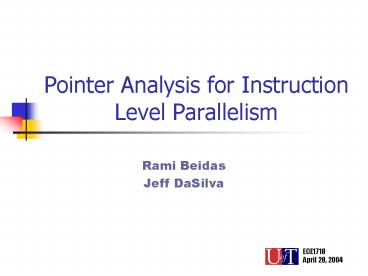Pointer Analysis for Instruction Level Parallelism PowerPoint PPT Presentation
1 / 19
Title: Pointer Analysis for Instruction Level Parallelism
1
Pointer Analysis for Instruction Level
Parallelism
Rami Beidas Jeff DaSilva
ECE1718 April 28, 2004
2
Motivation
3
Motivation
- Software developers utilize powerful pointer
constructs to realize complex data structure. - Optimizing compilers are typically conservative
with memory references that use pointers. - Efficient pointer alias analysis algorithms and
tools do exist. - SPAN
?Can a real pointer alias analysis tool improve
performance?
4
Project Objectives
- Determine the maximum available instruction level
parallelism when limited by a real pointer
analysis tool. - Design a framework for evaluating the
effectiveness of any pointer analysis tool.
5
Project Flow Graph
Simple Scalar Simulator
6
Annotating Static Memory References
int x, y int p_xx int p_yx p_x
if() p_y p_x p_y p_y
7
Pointer AnalysisLoad-Store Dependence Matrix
8
Pointer AnalysisDynamic Profiling Matrix
9
Pointer AnalysisSPAN
30
int x, y
31
31
30,31
10
ASM Annotation
Simple Scalar Simulator
- Alias-analysis results identify bounded memory
access regions - The need to pass alias-analysis results to
SimpleScalar Simulation engine
11
ASM Annotation
STR_BEGIN()
ASM OP (ANNOT1) ()
a b
STR_END
ASM OP (ANNOT2)
- The use of SimpleScalar annotation interface to
pass alias analysis results
16-ANNOT
16-op
8-rs
8-rt
16-imm
12
Simple Scalar Simulator
- Similar approach to HW1
- Schedule instructions, including memory accesses,
ASAP - Each memory access needs to be schedules when
parameters are available AND All CONFLICTING
MEMORY ACCESSES ARE COMPLETED
Simple Scalar Simulator
13
Simple Scalar Simulator
Mem Access 1
- Annotation instructions identify current memory
access ID - Check all conflicting memory accesses
- Schedule after the last conflicting access
Mem Access 2
Mem Access 3
. . .
Mem Access N
14
Results
15
Results
16
Results
17
Results
18
Conclusion
- Argued the benefits of using alias analysis
results in enhancing ILP - Proposed a well-defined methodology and framework
to measure the effect of using static pointer
analysis results on ILP - Presented the potential benefits of
memory-related static-analysis on ILP of a number
of testbenches
19
Future Work
- More experimental results on pointer-intensive
applications - A more realistic memory system
- A more realistic micro-architecture model (e.g.
sim-outorder)

